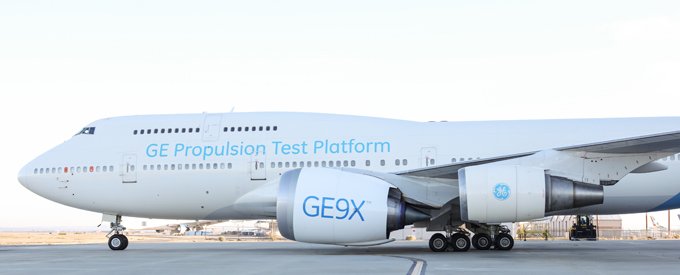2020-11-15
Flying Better with the GE9X
The GE9X engine is an engineering marvel whose beauty lies in the details. It is one of the largest in the world, fuel-efficient, quiet, offers the lowest emissions in its class, and is built with advanced techniques and materials.
The GE9X has only one fan, and at roughly 11 feet in diameter — wide as the body of a Boeing 737 — the giant fan is the engine’s most distinctive feature. It holds 16 sleek fan blades made from the latest generation carbon-fibre composite that is tough but lighter than titanium. The blades are so well engineered that New York’s Museum of Modern Art included its first generation, which GE developed for GE9X’s predecessor GE90 engine, in its design collection.
The fan and other technology inside the engine, including 3D-printed parts and space-age materials called ceramic matrix composites, allow it to generate 100,000 pounds of thrust, more than many fighter jets and the rocket used in America’s first manned space flight.
GE engineers 3D-printed six of the engine’s components and used advanced carbon fibre composites that are tough but lighter than titanium, reducing weight and cutting the number of fan blades from 22 to 16, compared with the GE90.
Parts made from tough-as-steel, heat-resistant ceramic matrix composites hold up to temperatures approaching a searing 2,400-degree Fahrenheit, where even the most advanced alloys grow soft.
The GE9X engine and the plane it was designed for, the 777X, will be 20 per cent more fuel-efficient than their predecessors.Recently, the engine got one step closer to service when the Federal Aviation Administration certified it. The certification, a key milestone, means GE can start making GE9X engines for commercial service.
Flying the Giant Engine
“Fuel is used as ballast to balance the weight of the GE9X and the unique pylon that mounts it to the wing. The 747-400 is modified with a manual fuel transfer system that can be controlled from the cockpit. With the GE9X on the left wing, the No. 3 reserve tank — in the right wing is kept full and the No. 2 reserve tank — in the left wing is kept empty. This keeps the weight relatively balanced laterally,” said Jon Ohman, who flew F-18 fighter jets before becoming GE Aviation’s chief test pilot.
Ohman has first-hand experience with the GE9X. He spent 2018 and 2019 testing it in the skies above Victorville, California. It’s where GE keeps its Flying Test Bed, a modified Boeing 747 powered by three GE CF6 jet engines and, right now, the GE9X.
For planning purposes, Boeing provides test pilots with performance calculations for the unique configuration of 747 with the variety of test engines. With the GE9X producing significantly more thrust than a production CF6 engine, take-off and climb performance is reportedly excellent. With the GE9X and full take-off thrust the test pilots actually have to reduce the thrust of the No. 1 engine to ensure adequate directional control in the event of a failure of the No. 4 engine. Cruise performance with respect to overall fuel burn is slightly higher than normal, mainly due to additional drag from asymmetric configuration.
Considering the power of GE9X, is it possible for a Boeing 747-8 — the latest model of the iconic 747 jet — to operate on two GE9Xs? Are two GE9Xs more powerful than the four GEnx engines powering production 747-8 planes?
The GE9X is currently rated at 105,000 pounds of thrust. The four GEnx-2B engines on the 747-8 are rated at 66,500 pounds of thrust each, so two GE9Xs would not provide the same thrust. Also, the 747-8 is designed as a four-engine airplane with redundant electrical, hydraulic and bleed air systems powered by each of the four engines.
The GE9X engine hangs low on the test plane. Mounting an engine of this size to 747-400 is a challenge. The engine is mounted on a unique pylon that cantilevers the engine out in front of the wing and tilts it upward by approximately seven degrees. Also, the landing gear struts are over-serviced to extend them more than normal and provide an additional four inches of clearance. The result is about 18 inches of clearance between the bottom of the nacelle and the ground when the airplane is sitting stationary. Given the relatively small clearance, the pilots are very careful during landings, particularly in crosswinds.


No Comments